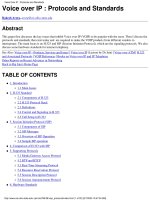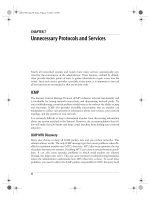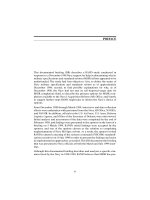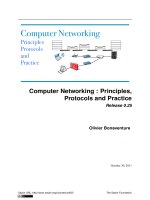wireless mesh networking architectures, protocols and standards
Bạn đang xem bản rút gọn của tài liệu. Xem và tải ngay bản đầy đủ của tài liệu tại đây (6.09 MB, 610 trang )
WIRELESS
MESH
NETWORKING
Yan Zhang / Wireless Mesh Networking AU7399_C000 Final Proof page i 30.10.2006 7:58pm
Architecting the Telecommunication
Evolution: Toward Converged Network
Services
Vijay K. Gurbani and Xian-He Sun
ISBN: 0-8493-9567-4
Business Strategies for the
Next-Generation Network
Nigel Seel
ISBN: 0-8493-8035-9
Chaos Applications in
Telecommunications
Peter Stavroulakis
ISBN: 0-8493-3832-8
Context-Aware Pervasive Systems:
Architectures for a New Breed of
Applications
Seng Loke
ISBN: 0-8493-7255-0
Fundamentals of DSL Technology
Philip Golden, Herve Dedieu, Krista S Jacobsen
ISBN: 0-8493-1913-7
Introduction to Mobile Communications:
Technology, Services, Markets
Tony Wakefield
ISBN: 1-4200-4653-5
IP Multimedia Subsystem: Service
Infrastructure to Converge NGN,
3G and the Internet
Rebecca Copeland
ISBN: 0-8493-9250-0
MPLS for Metropolitan Area Networks
Nam-Kee Tan
ISBN: 0-8493-2212-X
Performance Modeling and Analysis of
Bluetooth Networks: Polling, Scheduling,
and Traffic Control
Jelena Misic and Vojislav B Misic
ISBN: 0-8493-3157-9
A Practical Guide to Content Delivery
Networks
Gilbert Held
ISBN: 0-8493-3649-X
Resource, Mobility, and Security
Management in Wireless Networks
and Mobile Communications
Yan Zhang, Honglin Hu, and Masayuki Fujise
ISBN: 0-8493-8036-7
Security in Distributed, Grid, Mobile,
and Pervasive Computing
Yang Xiao
ISBN: 0-8493-7921-0
TCP Performance over UMTS-HSDPA
Systems
Mohamad Assaad and Djamal Zeghlache
ISBN: 0-8493-6838-3
Testing Integrated QoS of VoIP:
Packets to Perceptual Voice Quality
Vlatko Lipovac
ISBN: 0-8493-3521-3
The Handbook of Mobile Middleware
Paolo Bellavista and Antonio Corradi
ISBN: 0-8493-3833-6
Traffic Management in IP-Based
Communications
Trinh Anh Tuan
ISBN: 0-8493-9577-1
Understanding Broadband over
Power Line
Gilbert Held
ISBN: 0-8493-9846-0
Understanding IPTV
Gilbert Held
ISBN: 0-8493-7415-4
WiMAX: A Wireless Technology
Revolution
G.S.V. Radha Krishna Rao, G. Radhamani
ISBN: 0-8493-7059-0
WiMAX: Taking Wireless to the MAX
Deepak Pareek
ISBN: 0-8493-7186-4
Wireless Mesh Networking: Architectures,
Protocols and Standards
Yan Zhang, Jijun Luo and Honglin Hu
ISBN: 0-8493-7399-9
Wireless Mesh Networks
Gilbert Held
ISBN: 0-8493-2960-4
AUERBACH PUBLICATIONS
www.auerbach-publications.com
To Order Call: 1-800-272-7737 • Fax: 1-800-374-3401
E-mail:
OTHER TELECOMMUNICATIONS BOOKS FROM AUERBACH
Yan Zhang / Wireless Mesh Networking AU7399_C000 Final Proof page ii 30.10.2006 7:58pm
Boca Raton New York
Auerbach Publications is an imprint of the
Taylor & Francis Group, an informa business
WIRELESS
MESH
NETWORKING
Architectures, Protocols and Standards
Edited by
Yan Zhang • Jijun Luo • Honglin Hu
Yan Zhang / Wireless Mesh Networking AU7399_C000 Final Proof page iii 30.10.2006 7:58pm
Auerbach Publications
Taylor & Francis Group
6000 Broken Sound Parkway NW, Suite 300
Boca Raton, FL 33487-2742
© 2007 by Taylor & Francis Group, LLC
Auerbach is an imprint of Taylor & Francis Group, an Informa business
No claim to original U.S. Government works
Printed in the United States of America on acid-free paper
10 9 8 7 6 5 4 3 2 1
International Standard Book Number-10: 0-8493-7399-9 (Hardcover)
International Standard Book Number-13: 978-0-8493-7399-2 (Hardcover)
This book contains information obtained from authentic and highly regarded sources. Reprinted
material is quoted with permission, and sources are indicated. A wide variety of references are
listed. Reasonable efforts have been made to publish reliable data and information, but the author
and the publisher cannot assume responsibility for the validity of all materials or for the conse-
quences of their use.
No part of this book may be reprinted, reproduced, transmitted, or utilized in any form by any
electronic, mechanical, or other means, now known or hereafter invented, including photocopying,
microfilming, and recording, or in any information storage or retrieval system, without written
permission from the publishers.
For permission to photocopy or use material electronically from this work, please access www.
copyright.com ( or contact the Copyright Clearance Center, Inc. (CCC)
222 Rosewood Drive, Danvers, MA 01923, 978-750-8400. CCC is a not-for-profit organization that
provides licenses and registration for a variety of users. For organizations that have been granted a
photocopy license by the CCC, a separate system of payment has been arranged.
Trademark Notice: Product or corporate names may be trademarks or registered trademarks, and
are used only for identification and explanation without intent to infringe.
Visit the Taylor & Francis Web site at
and the Auerbach Web site at
Yan Zhang / Wireless Mesh Networking AU7399_C000 Final Proof page iv 30.10.2006 7:58pm
CONTENTS
Editors vii
Contributors ix
Preface xiii
PART I: ARCHITECTURES
1
Wireless Mesh Networks: Issues and Solutions 3
B.S. MANOJ AND RAMESH R. RAO
2 Multiradio Multichannel Mesh Networks 49
RAJIV VIJAYAKUMAR, ARINDAM DAS, SUMIT ROY, AND HUI MA
3 IEEE 802.11-Based Wireless Mesh Networks 79
ASHISH RANIWALA, RUPA KRISHNAN, AND TZI-CKER CHIUEH
PART II: PROTOCOLS
4
Routing in Wireless Mesh Networks 113
MICHAEL BAHR, JIANPING WANG, AND XIAOHUA JIA
5 Medium Access Control in Wireless Mesh Networks 147
MICHELLE X. GONG, SHIWEN MAO, SCOTT F. MIDKIFF, AND
BRIAN HART
6 Security in Wireless Mesh Networks 183
RAINER FALK, CHIN-TSER HUANG, FLORIAN KOHLMAYER,
AND AI-FEN SUI
7 Scalability in Wireless Mesh Networks 225
JANE-HWA HUANG, LI-CHUN WANG, AND CHUNG-JU CHANG
8 Load Balancing in Wireless Mesh Networks 263
B.S. MANOJ AND RAMESH R. RAO
Yan Zhang / Wireless Mesh Networking AU7399_C000 Final Proof page v 30.10.2006 7:58pm
9 Cross-Layer Optimization for Scheduling
in Wireless Mesh Networks 297
VASILIS FRIDERIKOS, KATERINA PAPADAKI,
DAVID WISELY, AND HAMID AGHVAMI
10 Multimedia Communications over
Wireless Mesh Networks 329
ENRICO MASALA, ANTONIO SERVETTI, AND
JUAN CARLOS DE MARTIN
11 Multiple Antenna Techniques for
Wireless Mesh Networks 361
HONGLIN HU, JIJUN LUO, AND XIAODONG ZHANG
PART III: STANDARDIZATION AND ENABLING
TECHNOLOGIES
12
Standardization of Wireless LAN Mesh
Networks in IEEE 802.11s 391
SHAH I. RAHMAN
13 IEEE 802.16 WiMAX Mesh Networking 425
YAN ZHANG, KEAN-SOON TAN, PENG-YONG KONG,
JUN ZHENG, AND MASAYUKI FUJISE
14 Cognitive Radio and Dynamic
Spectrum Management 467
CLEMENS KLOECK, VOLKER BLASCHKE, HOLGER JAEKEL,
FRIEDRICH K. JONDRAL, DAVID GRANDBLAISE,
JEAN-CHRISTOPHE DUNAT, AND SOPHIE GAULT
15 Wireless Mesh Networks Case Study: Fire
Emergency Management and Market Analysis 509
CARLES GOMEZ, PAU PLANS, MARISA CATALAN, JOSEP LLUIS
FERRER, JOSEP PARADELLS, ANNA CALVERAS, JAVIER RUBIO,
AND DANIEL ALMODOVAR
16 Wireless Mesh Networks for Public
Safety and Disaster Recovery Applications 545
MARIUS PORTMANN
Index 577
Yan Zhang / Wireless Mesh Networking AU7399_C000 Final Proof page vi 30.10.2006 7:58pm
EDITORS
Yan Zhang received a Ph.D. degree from the School of Electrical &
Electronics Engineering, Nanyang Technological University, Singapore.
From August 2004 to May 2006, he worked with NICT Singapore,
National Institute of Information and Communications Technology
(NICT). From August 2006, he has worked with Simula Research
Laboratory, Norway ( ).
Dr. Zhang is on the editorial board of International Journal
of Network Security and is currently serving as the series editor for
the book series ‘‘Wireless Networks and Mobile Communications’’
(Auerbach Publications, CRC Press, Taylor & Francis Group). He also
serves as co-editor for several books: Resource, Mobility and Security
Management in Wireless Networks and Mobile Communications;
Wireless Mesh Networking: Architectures, Protocols and Standards;
Millimeter-Wave Technology in Wireless PAN, LAN and MAN; Dis-
tributed Antenna Systems: Open Architecture for Future Wireless
Communications; Security in Wireless Mesh Networks; Wireless Metro-
politan Area Networks: WiMAX and Beyond; Wireless Quality-
of-Service: Techniques, Standards; and Applications; Broadband
Mobile Multimedia: Techniques and Applications; Internet of Things:
From RFID to the Next-Generation Pervasive Networked Systems; and
Handbook of Research on Wireless Security.
He serves as program co-chair for IEEE PCAC’07, special track
co-chair for ‘‘Mobility and Resource Management in Wireless/Mobile
Networks’’ in ITNG 2007, special session co-organizer for ‘‘Wireless
Mesh Networks’’ in PDCS 2006, is a member of the Technical Program
Committee for IEEE AINA 2007, IEEE CCNC 2007, WASA’06, IEEE
GLOBECOM’2006, IEEE WoNGeN’06, IEEE IWCMC 2006, IEEE IWCMC
2005, ITST 2006, and ITST 2005. His research interests include
resource, mobility, energy and security management in wireless networks
Yan Zhang / Wireless Mesh Networking AU7399_C000 Final Proof page vii 30.10.2006 7:58pm
and mobile computing. He is a member of IEEE and IEEE ComSoc.
Email:
Jijun Luo received his master of engineering (M. Eng.) degree from
Shandong University, China in 1999 and a master of science (M. Sc.)
degree from Munich University of Technology, Germany in 2000. He
joined Siemens in 2000 and pursued his doktor-ingenieur (Dr. Ing.)
degree at RWTH Aachen University, Germany. Until now he has
published more than 100 technical papers, co-authored three books
and holds many patents. His technical contributions mainly cover
his findings on wireless communication system design, radio protocol,
system architecture, radio resource management, signal processing,
coding and modulation technologies. He is active in international
academy and research activities. He serves as invited reviewer of
IEEE Transactions on Vehicular Technology, IEEE Communica-
tions Magazine, IEEE Wireless Communications Magazine, EURASIP
Journals, Frequenz, etc. He has been nominated as session chair
and reviewer of many high-level technical conferences organized by
IEEE and European research organizations. He is leading European
research projects and is active in international industrial standardiza-
tion bodies. His main interests are transmission technologies, radio
resource management, reconfigurability (software-defined radio) and
radio system design. He is a member of IEEE. Email:
Honglin Hu received his Ph.D. degree in communications and infor-
mation systems in January 2004 from the University of Science and
Technology of China (USTC), Hefei, China. From July 2004 to January
2006, he was with Future Radio, Siemens AG Communications in
Munich, Germany. Since January 2006, he has been with the Shanghai
Research Center for Wireless Communications (SHRCWC), which is
also known as the International Center for Wireless Collaborative
Research (Wireless CoRe). Meanwhile, he serves as the an associate
professor at the Shanghai Institute of Microsystem and Information
Technology (SIMIT), Chinese Academy of Science (CAS). Dr. Hu is
mainly working for international standardization and other collabora-
tive activities. He is a member of IEEE, IEEE ComSoc, and IEEE TCPC.
In addition, he serves as a member of Technical Program Committee
for IEEE WirelessCom 2005, IEEE ICC 2006, IEEE IWCMC 2006, IEEE
ICC 2007, IEEE/ACM Q2SWinet 2006. Since June 2006, he has served,
on the editorial board of Wireless Communications and Mobile
Computing, John Wiley & Sons. Email:
Yan Zhang / Wireless Mesh Networking AU7399_C000 Final Proof page viii 30.10.2006 7:58pm
CONTRIBUTORS
Hamid Aghvami
Centre for Telecommunications
Research
King’s College
London, United Kingdom
Daniel Almodovar
Vodafone Group Research
and Development
Madrid, Spain
Michael Bahr
Siemens AG
Corporate Technology
Munich, Germany
Volker Blaschke
Nachrichtentechnik
Universita
¨
t Karlsruhe
Karlsruhe, Germany
Anna Calveras
Wireless Networks Group
Technical University of Catalonia
Barcelona, Spain
Marisa Catalan
Wireless Networks Group
Technical University of Catalonia
Barcelona, Spain
Chung-Ju Chang
Department of Communication
Engineering
National Chiao-Tung University
Hsinchu, Taiwan
People’s Republic of China
Tzi-Cker Chiueh
Department of Computer
Science
Stony Brook University
Stony Brook, New York
Arindam Das
Department of Electrical
Engineering
University of Washington,
Seattle, Washington
Juan Carlos De Martin
Computer and Control Engineering
Department
Politecnico di Torino
Torino, Italy
Jean-Christophe Dunat
Motorola Laboratories
Gif sur Yvette, France
Yan Zhang / Wireless Mesh Networking AU7399_C000 Final Proof page ix 30.10.2006 7:58pm
Rainer Falk
Siemens AG
Corporate Technology
Munich, Germany
Josep Lluis Ferrer
Wireless Networks Group
Technical University of Catalonia
Barcelona, Spain
Vasilis Friderikos
Centre for Telecommunications
Research
King’s College
London, United Kingdom
Masayuki Fujise
Wireless Communications
Laboratory
National Institute of Information
and Communications Technology
Singapore
Sophie Gault
Motorola Laboratories
Gif sur Yvette, France
Carles Gomez
Wireless Networks Group
Technical University of Catalonia
Barcelona, Spain
Michelle X. Gong
Cisco Systems
San Jose, California
David Grandblaise
Motorola Laboratories
Gif sur Yvette, France
Brian Hart
Cisco Systems
San Jose, California
Honglin Hu
Shanghai Research Center for
Wireless Communications
Shanghai, People’s Republic of China
Chin-Tser Huang
Department of Computer Science
and Engineering
University of South Carolina
Columbia, South Carolina
Jane-Hwa Huang
Department of Communication
Engineering
National Chiao-Tung University
Hsinchu, Taiwan
People’s Republic of China
Holger Jaekel
Nachrichtentechnik
Universita
¨
t Karlsruhe
Karlsruhe, Germany
Xiaohua Jia
Department of Computer Science
City University of Hong Kong
Kowloon, Hong Kong
Friedrich K. Jondral
Nachrichtentechnik
Universita
¨
t Karlsruhe
Karlsruhe, Germany
Clemens Kloeck
Nachrichtentechnik
Universita
¨
t Karlsruhe
Karlsruhe, Germany
Florian Kohlmayer
Siemens AG
Corporate Technology
Munich, Germany
Yan Zhang / Wireless Mesh Networking AU7399_C000 Final Proof page x 30.10.2006 7:58pm
Peng-Yong Kong
Institute for Infocomm
Research
Singapore
Rupa Krishnan
Department of Computer Science
Stony Brook University
Stony Brook, New York
Jijun Luo
Future Radio, Siemens AG
Munich, Germany
Hui Ma
Department of Electrical
Engineering
University of Washington
Seattle, Washington
B.S. Manoj
Department of Electrical and
Computer Engineering
University of California
San Diego, California
Shiwen Mao
Department of Electrical and
Computer Engineering
Auburn University
Auburn, Alabama
Enrico Masala
Computer and Control Engineering
Department
Politecnico di Torino
Torino, Italy
Scott F. Midkiff
ECE Department,
Virginia polytechnic Institute and
State University
Arlington, Virginia
Katerina Papadaki
Operational Research
Department
London School of Economics
London, United Kingdom
Josep Paradells
Wireless Networks Group
Technical University of Catalonia
Barcelona, Spain
Pau Plans
Wireless Networks Group
Technical University
of Catalonia
Barcelona, Spain
Marius Portmann
School of ITEE
University of Queensland
Brisbane, Australia
Shah I. Rahman
Cisco Systems
San Jose, California
Ashish Raniwala
Department of Computer
Science
Stony Brook University
Stony Brook, New York
Ramesh R. Rao
Department of Electrical and
Computer Engineering
University of California
San Diego, California
Sumit Roy
Department of Electrical
Engineering
University of Washington
Seattle, Washington
Yan Zhang / Wireless Mesh Networking AU7399_C000 Final Proof page xi 30.10.2006 7:58pm
Javier Rubio
Vodafone Group Research
and Development
Madrid, Spain
Antonio Servetti
Computer and Control
Engineering Department
Politecnico di Torino
Torino, Italy
Ai-Fen Sui
Siemens Ltd. China
Corporate Technology
Department Information Security
Beijing, People’s Republic of China
Kean-Soon Tan
Institute for Infocomm Research
Singapore
Rajiv Vijayakumar
Department of Electrical
Engineering
University of Washington
Seattle, Washington
Jianping Wang
Department of Computer and
Information Science
University of Mississippi
University, Mississippi
Li-Chun Wang
Department of Communication
Engineering
National Chiao-Tung University
Hsinchu, Taiwan
People’s Republic of China
David Wisely
Mobility Research, BT Group
Ipswich, United Kingdom
Xiaodong Zhang
Shanghai Research Center for
Wireless Communications
Shanghai, People’s Republic
of China
Yan Zhang
Simula Research Laboratory
Oslo, Norway
Jun Zheng
Computer Science Department
Queens College-City University
Flushing, New York
Yan Zhang / Wireless Mesh Networking AU7399_C000 Final Proof page xii 30.10.2006 7:58pm
PREFACE
Wireless Mesh Networks (WMN) are believed to be a highly promising
technology and will play an increasingly important role in future
generation wireless mobile networks. WMN is characterized by
dynamic self-organization, self-configuration and self-healing to
enable quick deployment, easy maintenance, low cost, high scalability
and reliable services, as well as enhancing network capacity, connect-
ivity and resilience. Due to these advantages, international standard-
ization organizations are actively calling for specifications for mesh
networking modes, e.g., IEEE 802.11, IEEE 802.15, IEEE 802.16 and
IEEE 802.20. As a great extension to the ad hoc network, WMN is
becoming an important mode complementary to the infrastructure-
based wireless networks. The experiences obtained from studying
and deploying WMN provide us knowledge and reference to the
future networks evolution.
Wireless Mesh Networking: Architectures, Protocols and Standards
provides a comprehensive technical guide covering introductory
concepts, fundamental techniques, recent advances and open issues
in wireless mesh networks. It focuses on concepts, effective protocols,
system integration, performance analysis techniques, simulation,
experiments, and future directions. It explores various key challenges,
diverse scenarios and emerging standards such as those for capacity,
coverage, scalability, extensibility, reliability, and cognition. This vol-
ume contains illustrative figures and complete cross-referencing on
routing, security, spectrum management, medium access, cross-layer
optimization, load-balancing, multimedia communication, MIMO, and
smart antennas, etc. It also details information on particular techniques
for efficiently improving the performance of a wireless mesh network.
Yan Zhang / Wireless Mesh Networking AU7399_C000 Final Proof page xiii 30.10.2006 7:58pm
This book is organized in three parts:
&
Part I: Architectures
&
Part II: Protocols
&
Part III: Standardization and Enabling Technologies
In Part I, WMN fundamentals are briefly introduced as are various
types of network architecture. Part II concentrates on the techniques
necessary to enable a complete, secure and reliable wireless network,
including routing, security, medium access control (MAC), scalability,
load balancing, cross layer optimization, scheduling, multimedia com-
munication, MIMO (or multiple antenna system). Part III explores
standardization activities and particular mesh network specifications
in the emerging standards, for instance, mesh mode in the IEEE 802.11
Wireless LAN and in the IEEE 802.16 WiMAX. In addition, the appli-
cations of mesh networks in emergency management, and public
safety are exploited.
This book has the following salient features:
&
Provides a comprehensive reference on state-of-the-art
technologies for wireless mesh networks
&
Identifies basic concepts, techniques, advanced research topics
and future directions
&
Contains illustrative figures that enable easy understanding of
wireless mesh networks
&
Allows complete cross-referencing via the broad coverage of
different layers of protocol stacks
&
Details particular techniques for efficiently improving the per-
formance of wireless mesh networks
This book can serve as a useful reference for students, educators,
faculties, telecom service providers, research strategists, scientists,
researchers, and engineers in the fields of wireless networks and
mobile communications.
We would like to acknowledge the effort and time invested by all
contributors for their excellent work. They were extremely profes-
sional and cooperative. Special thanks go to Richard O’Hanley, Kim
Hackett, Catherine Giacari, Glenon Butler and Jessica Vakili of Taylor
& Francis Group for their support, patience and professionalism
from the beginning to the final stage. We are grateful for Suryakala
Arulprakasam for her great efforts during the typesetting period. Last
Yan Zhang / Wireless Mesh Networking AU7399_C000 Final Proof page xiv 30.10.2006 7:58pm
but not least, a special thank you to our families and friends for their
constant encouragement, patience and understanding throughout this
project.
Yan Zhang, Jijun Luo,
and Honglin Hu
Yan Zhang / Wireless Mesh Networking AU7399_C000 Final Proof page xv 30.10.2006 7:58pm
Yan Zhang / Wireless Mesh Networking AU7399_C000 Final Proof page xvi 30.10.2006 7:58pm
PART I
ARCHITECTURES
Yan Zhang / Wireless Mesh Networking AU7399_C001 Final Proof page 1 23.10.2006 1:43pm
Yan Zhang / Wireless Mesh Networking AU7399_C001 Final Proof page 2 23.10.2006 1:43pm
1
WIRELESS MESH
NETWORKS: ISSUES AND
SOLUTIONS
B.S. Manoj and Ramesh R. Rao
CONTENTS
1.1 Introduction 5
1.2 Comparison between wireless
ad hoc and mesh networks 6
1.3 Challenges in wireless mesh networks 8
1.3.1 Throughput capacity 9
1.3.2 Throughput fairness 10
1.3.3 Reliability and robustness 12
1.3.4 Resource management 13
1.4 Design issues in wireless mesh networks 13
1.4.1 Network architectural design issues 14
1.4.1.1 Flat wireless mesh network 14
1.4.1.2 Hierarchical wireless mesh network 14
1.4.1.3 Hybrid wireless mesh network 14
1.4.2 Network protocol design issues 15
1.4.2.1 Physical layer design issues 15
1.4.2.2 Medium access control layer 16
1.4.2.3 Network layer 16
1.4.2.4 Transport layer 17
1.4.2.5 Application layer 17
1.4.2.6 System-level design issues 17
4
Yan Zhang / Wireless Mesh Networking AU7399_C001 Final Proof page 3 23.10.2006 1:43pm
3
1.5 Design issues in multiradio wireless mesh networks 18
1.5.1 Architectural design issues 18
1.5.2 Medium access control design issues 19
1.5.3 Routing protocol design issues 20
1.5.4 Routing metric design issues 21
1.5.5 Topology control design issues 22
1.6 Link layer solutions for multiradio wireless
mesh networks 23
1.6.1 Multiradio unification protocol 24
1.7 Medium access control protocols for multiradio
wireless mesh networks 28
1.7.1 Multichannel CSMA MAC 28
1.7.2 Interleaved carrier sense multiple access 29
1.7.3 Two-phase TDMA-based medium
access control scheme 31
1.8 Routing protocols for multiradio
wireless mesh networks 34
1.8.1 New routing metrics for multiradio
wireless mesh networks 34
1.8.2 Multiradio link quality source routing 36
1.8.3 Load-aware interference balanced
routing protocol 40
1.9 Topology control schemes for multiradio
wireless mesh networks 41
1.9.1 Objectives of topology control protocols 41
1.9.2 The backbone topology synthesis algorithm 42
1.10 Open issues 45
1.11 Summary 46
References 46
1.1 INTRODUCTION
Wireless mesh network (WMN) is a radical network form of the ever-
evolving wireless networks that marks the divergence from the trad-
itional centralized wireless systems such as cellular networks and
wireless local area networks (LANs). Similar to the paradigm shift,
experienced in wired networks during the late 1960s and early 1970s
that led to a hugely successful and distributed wired network form—
the Internet—WMNs are promising directions in the future of wireless
networks. The primary advantages of a WMN lie in its inherent
fault tolerance against network failures, simplicity of setting up a
network, and the broadband capability. Unlike cellular networks
Yan Zhang / Wireless Mesh Networking AU7399_C001 Final Proof page 4 23.10.2006 1:43pm
4
&
Wireless Mesh Networking
where the failure of a single base station (BS) leading to unavailability
of communication services over a large geographical area, WMNs
provide high fault tolerance even when a number of nodes fail.
Although by definition a WMN is any wireless network having a
network topology of either a partial or full mesh topology, practical
WMNs are characterized by static wireless relay nodes providing a
distributed infrastructure for mobile client nodes over a partial mesh
topology. Due to the presence of partial mesh topology, a WMN
utilize multihop relaying similar to an ad hoc wireless network.
Although ad hoc wireless networks are similar to WMNs, the proto-
cols and architectures designed for the ad hoc wireless networks
perform very poorly when applied in the WMNs. In addition, the
optimal design criteria are different for both these networks. These
design differences are primarily originated from the application
or deployment objectives and the resource constraints in these net-
works. For example, an ad hoc wireless network is generally designed
for high mobility multihop environment; on the other hand, a WMN is
designed for a static or limited mobility environment. Therefore, a
protocol designed for ad hoc wireless networks may perform very
poorly in WMNs. In addition, WMNs are much more resource-rich
compared with ad hoc wireless networks. For example, in some
WMN applications, the network may have a specific topology and
hence protocols and algorithms need to be designed to benefit from
such special topologies. In addition, factors such as the inefficiency of
protocols, interference from external sources sharing the spectrum,
and the scarcity of electromagnetic spectrum further reduce the cap-
acity of a single-radio WMN. In order to improve the capacity of
WMNs and for supporting the traffic demands raised by emerging
applications for WMNs, multiradio WMNs (MR-WMNs) are under
intense research. Therefore, recent advances in WMNs are mainly
based on a multiradio approach. While MR-WMNs promise higher
capacity compared with single-radio WMNs, they also face several
challenges. This chapter focuses on the issues and challenges for both
single-radio WMNs and MR-WMNs, and discusses a set of existing
solutions for MR-WMNs. It begins with a comparison of WMNs with
ad hoc wireless networks and proceeds to discuss the issues and
challenges in MR-WMNs. The main contribution of this chapter is the
detailed discussion on the issues and challenges faced by MR-WMNs,
presentation with illustrations of a range of recent solutions for archi-
tectures, link layer protocols, medium access control (MAC) layer
protocols, network layer protocols, and topology control solutions
for MR-WMNs.
Yan Zhang / Wireless Mesh Networking AU7399_C001 Final Proof page 5 23.10.2006 1:43pm
Wireless Mesh Networks: Issues and Solutions
&
5
1.2 COMPARISON BETWEEN WIRELESS
AD HOC AND MESH NETWORKS
Figure 1.1 shows the classification of multihop wireless networks;
these constitute the category of wireless networks that primarily use
multihop wireless relaying. The major categories in the multihop
wireless networks are the ad hoc wireless networks, WMNs, wireless
sensor networks, and hybrid wireless networks. This book mainly
focuses on WMNs. Ad hoc wireless networks [12] are mainly infra-
structureless networks with highly dynamic topology. Wireless sensor
networks, formed by tiny sensor nodes that can gather physical
parameters and transmit to a central monitoring node, can use either
single-hop wireless communication or a multihop wireless relaying.
Hybrid wireless networks [12] utilize both single- and multihop com-
munications simultaneously within the traditionally single-hop wire-
less networks such as cellular networks and wireless in local loops
(WiLL). WMNs use multihop wireless relaying over a partial mesh
topology for its communication.
Table 1.1 compares the wireless ad hoc networks and WMNs. The
primary differences between these two types of networks are mobility
of nodes and network topology. Wireless ad hoc networks are high
mobility networks where the network topology changes dynamically.
On the other hand, WMNs do have a relatively static network with
most relay nodes fixed. Therefore, the network mobility of WMNs
is very low in comparison with wireless ad hoc networks. The
Wireless Ad hoc
Networks
Wireless Mesh
Networks
Multihop Wireless Networks
Wireless Sensor Networks
Hybrid Wireless Networks
Figure 1.1 Classification of multihop wireless networks.
Yan Zhang / Wireless Mesh Networking AU7399_C001 Final Proof page 6 23.10.2006 1:43pm
6
&
Wireless Mesh Networking
topological difference in these networks also contributes to the differ-
ence in performance in routing. For example, while the on-demand
routing protocols perform better in wireless ad hoc networks, the
relatively static hierarchical or table-driven routing protocols perform
better in WMNs. Due to the static topology, formed by fixed relay
nodes, of WMNs, most WMNs have better energy storage and power
source, thus removing one of the biggest constraint in wireless ad hoc
networks—the energy constraint. Finally, another important differ-
ence between these two categories of networks is the application
scenario. Unlike wireless ad hoc networks, WMNs are used for both
military and civilian applications. Some of the popular civilian appli-
cations of WMNs include provisioning of low-cost Internet services to
shopping malls, streets, and cities.
Table 1.1 Differences between Ad Hoc Wireless Networks
and Wireless Mesh Networks
Issue
Wireless Ad
Hoc Networks
Wireless
Mesh Networks
Network topology Highly dynamic Relatively static
Mobility of relay nodes Medium to high Low
Energy constraint High Low
Application
characteristics
Temporary Semipermanent or
permanent
Infrastructure
requirement
Infrastructureless Partial or fully fixed
infrastructure
Relaying Relaying by mobile
nodes
Relaying by fixed nodes
Routing performance Fully distributed
on-demand routing
preferred
Fully distributed or
partially distributed
with table-driven or
hierarchical routing
preferred
Deployment Easy to deploy Some planning
required
Traffic characteristics Typically user traffic Typically user and
sensor traffic
Popular application
scenario
Tactical
communication
Tactical and civilian
communication
Yan Zhang / Wireless Mesh Networking AU7399_C001 Final Proof page 7 23.10.2006 1:43pm
Wireless Mesh Networks: Issues and Solutions
&
7
1.3 CHALLENGES IN WIRELESS MESH NETWORKS
Traditional wireless ad hoc networks and WMNs were based on a
single-channel or single-radio interface. WMNs, irrespective of its
simplicity and high fault tolerance, face a significant limitation of
limited network capacity. While the theoretical upper limit of the
per node throughput capacity is asymptotically limited by
O(1=
ffiffiffi
n
p
), theoretically achievable capacity to every node in a
random static wireless ad hoc network, with ideal global schedul-
ing and routing, is estimated [6] as Q(1/
p
n log n)wheren is the
number of nodes in the network. Therefore, with increasing num-
ber of nodes in a network, the throughput capacity becomes
unacceptably low. With the use of real MAC, routing, and transport
protocols and a realistic traffic pattern, the achievable capacity in
a WMN, in practice, is much less than the theoretical upper limit.
It has also been found [7] through experiments using carrier sense
multiple access with collision avoidance (CSMA/CA)-based MAC
protocol such as IEEE 802.11 that on a string topology, the
throughput degrades approximately to 1/n of the raw channel
bandwidth. In general, the throughput capacity achievable in an
arbitrary WMN is proportional to the Q(W Â n
À1=d
)whered is the
dimension of the network and W is the total bandwidth. For a two-
dimensional (2D) network, the throughput can be as small as
Q(W Â n
À1=2
). One approach to improve the throughput capacity
of a WMN is to use multiple radio interfaces. Although the upper
limit of the capacity is unaffected by the raw bandwidth or the
way the raw bandwidth is split among multiple interfaces, in
practice, with realistic MAC and routing protocols, the throughput
capacity can be significantly increased by the use of multiple inter-
faces and by fine tuning of protocols. Recently, the develop-
ment of WMNs using multiple radio interfaces have taken
significant process due to the availability of inexpensive and off-
the-shelf IEEE 802.11-based wireless interfaces. While MR-WMNs
provide several advantages such as increased network capacity,
they also face several issues and challenges. This chapter primarily
focuses on the issues and challenges in single-radio and MR-WMNs
andproceedstodiscusssomeofthe solutions for a multiradio
wireless network. The challenges faced by WMNs are discussed in
Section 1.3.1 through Section 1.3.4.
The primary challenges faced by WMNs such as throughput cap-
acity, network scalability, and other challenges are discussed here.
Yan Zhang / Wireless Mesh Networking AU7399_C001 Final Proof page 8 23.10.2006 1:43pm
8
&
Wireless Mesh Networking









